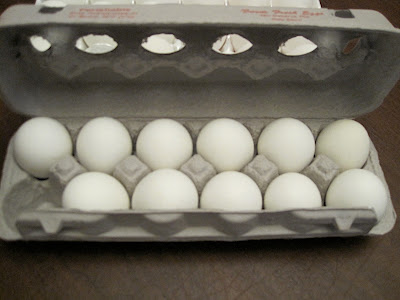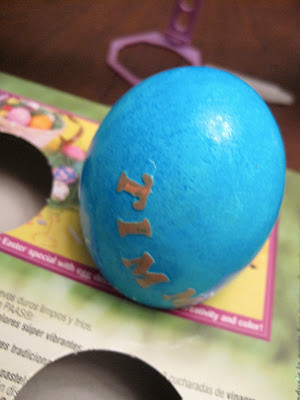I’m currently boiling eggs. I thought this would be a simple undertaking, getting the eggs in the fridge before dinnertime, so we can dye them after dinner tonight. It’s an Easter tradition…I did it every year as a kid, my boys have a good time with it and I look forward to seeing what creations we come up with this evening!
The sad thing, though, is that I’m the only one in the family who likes hard cooked eggs. This year I’m boiling 18 eggs and I’m thinking all along, “What the @#$%^ am I going to do with 18 hard-cooked eggs?” More precisely:
“What the @#$%^ am I going to do with 18 hard-cooked eggs before they go bad????” I can only tolerate but so much egg salad, and I don’t think my cholesterol count is going to appreciate me trying to eat 18 eggs in less than a week!
A bunch of us neighborhood stay-at-home Moms get together once a month for breakfast…it’s crossed my mind to just put a dozen of them in an Easter basket and present it for this week’s breakfast…except that they’d be rather old eggs by then.
This year, I decided I want to boil these eggs perfectly! This is the recipe I’ve elected to use this time around, and I think we have a winner! I’ve both overcooked and undercooked eggs. Most recently, I attempted Julia Child’s “Perfect Egg” recipe. Instead of sending you to a link, I’m going to put it right here, so everyone can see how complicated this is:
The Perfect Hard Boiled Egg
Recipe By : Julia Child, “The Way to Cook”
Serving Size : 1 Preparation Time :0:40
Categories : Cheese/Eggs Family Recipes
For 1-4 Eggs:
1 to 4 Eggs
2 quarts water — * see note
For 12 Eggs:
12 Eggs
3 1/2 quarts water — * see note
For 24 Eggs:
24 Eggs
6 quarts water — * see note
Special Equipment: High (not wide) Saucepan with cover, Bowl w/ice cubes & water (large enough to completely cover eggs)
*note: water should cover the eggs by 1 inch, so use a tall pan, and limit
cooking to 2 dozen eggs at a time.
1. Lay the eggs in the pan and add the amount of cold water specified. Set
over high heat and bring just to the boil; remove from heat, cover the pan,
and let sit exactly 17 minutes.
2. When the time is up, transfer the eggs to the bowl of ice cubes and
water. Chill for 2 minutes while bringing the cooking water to the boil
again. (This 2 minute chilling shrinks the body of the egg from the shell.)
3. Transfer the eggs (6 at a time only) to the boiling water, bring to the
boil again, and let boil for 10 seconds – this expands the shell from the
egg. Remove eggs, and place back into the ice water.
Chilling the eggs promptly after each step prevents that dark line from
forming, and if time allows, leave the eggs in the ice water after the last
step for 15 to 20 minutes. Chilled eggs are easier to peel, as well.
The peeled eggs will keep perfectly in the refrigerator, submerged in water
in an uncovered container, for 2 to 3 days.
So apparently when I cooked the eggs using Julia’s method, I messed something up, because I ended up with very difficult-to-peel eggs whose yolks were still liquid in the very center. Grosser than gross! I had only boiled 3 eggs to make a recipe of egg salad for a couple sandwiches, so at least it wasn’t a huge loss.
But Emeril’s recipe was spot-on! One of the eggs had a big crack when it was all done today, and when I peeled it, it was the most perfect yellow, with a shell that slipped right off…almost in one piece!
Anyway, enjoy a few pictures of our egg dyeing experience tonight.
The eggs on the left, missing the Eggland’s Best “EB” stamp , are the hard-cooked ones. The stamp came off in the boiling water.
These eggs came from the organic pork farm right up the street from us. We buy our pork products from their little shop, which is only open on weekends. Last weekend, they offered a free dozen of eggs to folks who were buying their Easter hams. So these were free eggs 🙂
This is one of the railroads Dave features on his model railroad.
This is another railroad Dave features.





















Recent Comments